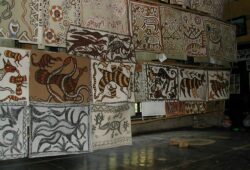The Last Judgment: Michelangelo’s Divine Masterpiece
 Posted On
Posted On
In the heart of the Vatican City, inside the Sistine Chapel, resides a work of art that has captivated and mystified viewers for centuries: “The Last Judgment” by the eminent Renaissance artist, Michelangelo Buonarroti. This monumental fresco, spanning the entire altar wall of the chapel, is a visual testament to the artist’s unparalleled genius and a profound representation of the Christian belief in the final reckoning of souls. With its intricate details, emotional intensity, and artistic brilliance, “The Last Judgment” remains a timeless masterpiece that continues to inspire awe and contemplation.
The Creation of a Masterpiece
Commissioned by Pope Clement VII in 1534 and later completed under the patronage of Pope Paul III in 1541, Michelangelo’s “The Last Judgment” was an ambitious project that tested the limits of the artist’s skill and imagination. Covering an area of 44 feet by 41 feet, the fresco depicts the second coming of Christ and the ultimate judgment of humanity.
Composition and Symbolism
At the centre of the composition, Christ stands in a majestic, triumphant pose, his right hand raised in a gesture of divine judgment, while his left hand points downwards, signalling the fate of the damned. The surrounding figures are a complex interplay of angels, saints, and souls, either ascending to heavenly glory or descending into the torturous abyss of Hell.
The lower section of the fresco portrays the damned being dragged down into the mouth of Hell by grotesque demons. This depiction of the damned is characterized by contorted, anguished bodies, exemplifying Michelangelo’s remarkable ability to convey profound emotion through his art. In contrast, the saved souls rise joyfully, guided by angels towards the celestial realm.
In the upper regions of the fresco, the Virgin Mary, surrounded by saints and apostles, pleads for mercy on behalf of humanity. St. Bartholomew, holding his own flayed skin, serves as a symbol of the artist himself, revealing Michelangelo’s self-awareness and introspection in his work.
Innovation and Controversy
“The Last Judgment” was not without its share of controversy. Michelangelo’s decision to depict many of the figures in a state of nudity was met with criticism from some religious authorities of the time. They argued that the nudity was inappropriate for a sacred space. In response, Michelangelo added strategically placed drapery to some of the figures, a compromise that allowed the fresco to retain its power and symbolism while appeasing his critics.
Legacy and Impact
Michelangelo’s “The Last Judgment” remains an indelible part of art history. Its influence on subsequent generations of artists cannot be overstated. The emotional intensity, anatomical precision, and spiritual depth of this masterpiece have served as a wellspring of inspiration for countless artists over the centuries.
The fresco’s enduring power lies in its ability to provoke contemplation about the human condition, morality, and the eternal struggle between good and evil. It reminds viewers of the consequences of their actions and the hope for redemption, encapsulating the essence of Christian eschatology.
“The Last Judgment” by Michelangelo is more than just a work of art; it is a profound spiritual and artistic achievement that transcends time and space. Its monumental scale, intricate details, and emotive power continue to captivate and inspire all who behold it. As we gaze upon this masterpiece, we are reminded of the eternal themes it represents and the enduring legacy of one of the greatest artists in history.



